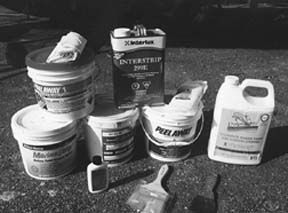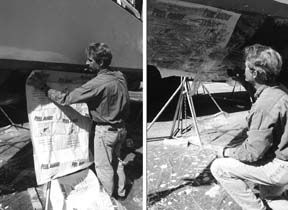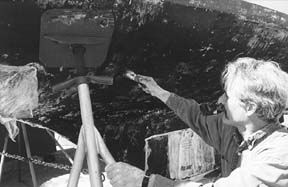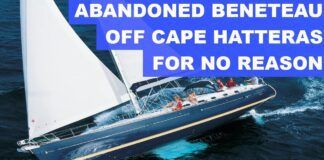What can we possibly say about bottom paint stripping that we haven’t already said?

X@#%*!
It’s a nasty job. Nothing fancy required. Just a paper suit, head piece, rubber gloves, a good scraper, a strong arm and a high threshold for pain!
The Choices We’ve Made
Over the years, we’ve tried everything—chemical paint strippers, sanding (wet and dry), and sand blasting with conventional media and baking soda. None are ideal or without risks. Strippers with methylene chloride are dangerous because the active ingredient is said to be carcinogenic. Even new “environmentally friendly” strippers contain some scary sounding chemicals—methyl ethyl ketone, acetone, tolune, dimer acid, hydroxyethanoic acid, dibasic ester and methyl-2-pyrrolidone. Some of these claim to be biodegradable but carry the skull and crossbones on the can and a warning, “Cannot be made non-poisonous.” Ingest it or get it in your eye, go to the hospital pronto. After all, this stuff’s job is to eat bottom paint…lots of it.
Sanding with a good random orbit tool or buffing wheel with foam pad and sandpaper puts up a cloud of dust, which isn’t much appreciated by your neighbors in the yard, and requires that you wear a respirator. It’ll take the arms out of a good man, especially when working overhead on the hull bottom. For several years we favored wet sanding using 3M abrasive sheets (they look like waffle-patterned screens) wrapped over a stiff sponge. The bottom paint dribbles off with the water so you don’t need a respirator, but you do need rags tied around your wrists so the dirty water doesn’t run down into your armpits—“Ooh!” These sheets cut fairly quickly, but it’s still a chore. And if your yard has been hassled by the environmental police about containing removed bottom paint, they might not like seeing rivers of blue, green and black water coursing through the yard.

Shotblasting, for us, was a one-shot trial. We had professionals blast part of our old C&C 33’s hull with Armex baking soda, and the results were quite good. But the company that was promoting the process to boat yards isn’t actively pursuing it any longer. Developed as an industrial cleaning process for jobs such as removing grease from equipment, it requires a skilled operator. Theoretically, at the right pressure, he can remove the paint without harming the gelcoat, but a few pounds over the limit and you’re blowing pin-size holes in your gelcoat. Which is precisely what happened when we rented our own equipment and tried blasting with conventional media. We stopped quickly.
Which brings us back around to chemical strippers…livin’ and dyin’, to paraphrase some country music singer, “with the choices we’ve made.”
Pick Your Poison
For several years now we have annually tested so-called “safe strippers,” that is, products without methylene chloride. Pretenders have come and gone, but Peel Away Marine Safety Strip, made by Dumond Chemicals, has always come out on top.
Last year we tested it against Dolphinite, Interlux Interstrip 299E, Napier SV-35M and West Marine MarineStrip. Peel Away won, followed by West Marine MarineStrip. Both require covering with paper or drop cloth plastic and fairly long waiting periods, up to 24 hours, though we found both achieved most of their action in far less time—around 4 hours. After 24 hours, the West Marine stripper had started to harden, making scraping of the residue difficult. Dolphinite and Interstrip 299E were effective, and require just 1-2 hours. But in gelcoat damage tests, we found that they can dramatically crack and lift gelcoat from its substrate. This appears to happen not only on bare gelcoat, but even “inside” bottom paint left on the hull. Our conclusion then was that users of these products should not put off scraping after applying the stripper—get the paint off now and then neutralize with a liberal spray of water from a hose. The Napier product is intended for professional use only by sprayer. It worked reasonably well.
All five products were retested as well as two recommended by readers—Peel Away #1, a home variety version of Peel Away Marine “seen on This Old House, Hometime, Home Again and many other DIY televisions shows,” and Soy-Gel™, made by Franmar Chemical, Inc.
Peel Away # 1 contains calcium hydroxide, magnesium hydroxide and sodium hydroxide. We were alerted to it by reader Les George of Tenants Harbor, Maine, who sent us a page from his Woodworkers Warehouse catalog, advertising a sale price of only $15.95 per gallon (list $29.99, usually discounted to $19.99).

We were somewhat surprised to read in a Peel Away 1 handout at a store that in addition to removing “up to 30 coats of paint in one application” from “almost all surfaces, wood, brick, concrete, plaster, steel, cast iron,” that it also offers “safe removal of marine coatings with NO damage to the fiberglass.” Hey, we thought this was for household use only! Aren’t we supposed to use the Peel Away Marine for our boats? Maybe we’re on to something here!
Soy-Gel does contain soybean oil; why we’re not sure. Soy is one of the politically/environmentally correct products these days, such as soy diesel fuel (wouldn’t it be great if one day we could grow all of our fuel?). The Material Safety Data Sheet (MSDS) says, “The precise composition of this product is proprietary information. A more complete discolsure will be provided to a physician in the event of a medical emergency.” The active—and hazardous—ingredient is n-methyl-2-pyrrolidone. Nevertheless, Franmar’s literature says it “meets San Diego’s toughest air quality requirements,” “No ODC’s, no HAP’s, Low VOC,” “Made from American grown soybeans,” “land-fill friendly, biodegradability at 28 days.”
The Test
Without a test boat of our own, we enlisted the aid of occasional PS contributor Dick Needham and his 1967 Pearson Renegade. He has owned the boat 12 years and never stripped the bottom. A perfect candidate for stripping. (You know you’re ready for a strip job when old bottom paint flakes off onto your roller when applying a new coat.) Dick has used black paint this entire time, covering old coats of blue paint.
Click here to view Bottom Paint Strippers Value Guide.
We marked off with tape seven squares on the keel about 1′ x 1-1/2′. Each of the strippers was applied as liberally as possible with a cheap, throw-away paint brush. You learn quickly that the thicker the stripper can be laid onto the surface, the better it will work. On a vertical surface, like the keel, or an upside-down horizontal surface, like the bottom of the hull, the thicker the gel, the more will stick. This may be Peel Away’s advantage, rather than the active chemicals used, because more of it stays on the hull than any of the others.
Per label instructions, Dolphinite was scraped after 1 hour, Interstrip 299E after 2 hours, Napier after 6 hours, and the other four—Peel Away 1 and Marine, West Marine MarineStrip and Soy-Gel—after 24 hours. (Franmar’s instructions say it may start softening the paint after 30 minutes to 2 hours; after 8 hours it may cause dulling, and over lengthy periods of 18 hours or more, damage to fiberglass may occur. Elsewhere it says that if left on overnight to cover it with plastic to keep it wet and active.)
Judging from the amount of black paint removed (the blue proved tenacious in most areas), Peel Away 1 and Marine Strip performed virtually the same, followed very closely by Soy-Gel. West Marine MarineStrip was next. Dolphinite and Interstrip 299E did very well, in much less time, but didn’t remove quite as much as the top finishers (perhaps because they don’t remain on the surface as long). Napier, we won’t count, because the ingredients seemed to have separated in the container from last year (watery) and did not apply well.

Conclusion
When it comes to removing layers of old bottom paint, there is no free lunch. If we could afford to have someone else do the job, that would be our first choice! Indeed, we’ve seen mobile outfits come into a job site with two- to three-men crews, lay down drop cloths, mask off the topsides, spray on the stripper, pressure wash, clean up and leave in less than a day. This is the sort of professional application for which Napier’s SV-35M is intended.
For a do-it-yourself job, off-the-shelf chemical strippers seem to be the easiest. Remember that thickness is everything. If you can lay the gel on 1/8″ to 1/4″ thick, most of the paint will scrape off like skinned-over pudding. Then spray with water, sand lightly and repaint.
Again in 2000, we have to say that Peel Away works best. Peel Away 1 is considerably less expensive than the Peel Away Marine Strip and appears to work just as well, at least on the one boat bottom we used for testing. Soy-Gel and West Marine MarineStrip would be our next choices. As noted earlier, we’d start work early in the day and check results before day’s end as leaving some of these gels on overnight seems too long a time, causing the gel to harden.
Dolphinite and Interstrip 299E work very well and much more quickly, so if you’re in a rush and don’t mind working with more voltatile chemicals (like acetone, tolulene, MEK, etc.), try them.
We’re inclined to use Peel Away for the total hull strip, then come back to problem spots with Dolphinite or Interstrip 299E.
You will, of course, have to finish any chemical strip job with at least a light sanding. Use a random orbit sander with #80-grit paper…and don’t spare the paper.
Contacts- Armex & Accustrip, in the Northeast, Dawson-McDonald, 845 Woburn St., Wilmington, MA 01887; 978/988-8034. For other distributor names, US Filter/Schmidt, 800/231-2085. Dolphinite, 43 Water St., Box 12, Beverly, MA 01915; 978/232-9832. Interstrip 299E, Interlux Yacht Finishes, 2270 Morris Ave., Union, NJ 07083; 800/INTERLUX, www.interlux.com. Napier International Technologies, 9439-192 Street, Surrey, British Columbia, Canada V4N 3R7; 800/564-9929. Peel Away 1 and Marine Safety Strip, Dumond Chemicals, 501 Broadway, New York, NY 10036; 212/869-6350, www.peelaway.com. Soy-Gel, Franmar Chemical, Inc., PO Box 97, Normal, IL 61761; 800/538-5069, www.soysolvents.com. West Marine, PO Box 50070, Watsonville, CA 95077-0070; 800/262-8464, www.westmarine.com. Woodworkers Warehouse, 888/234-8665.



































